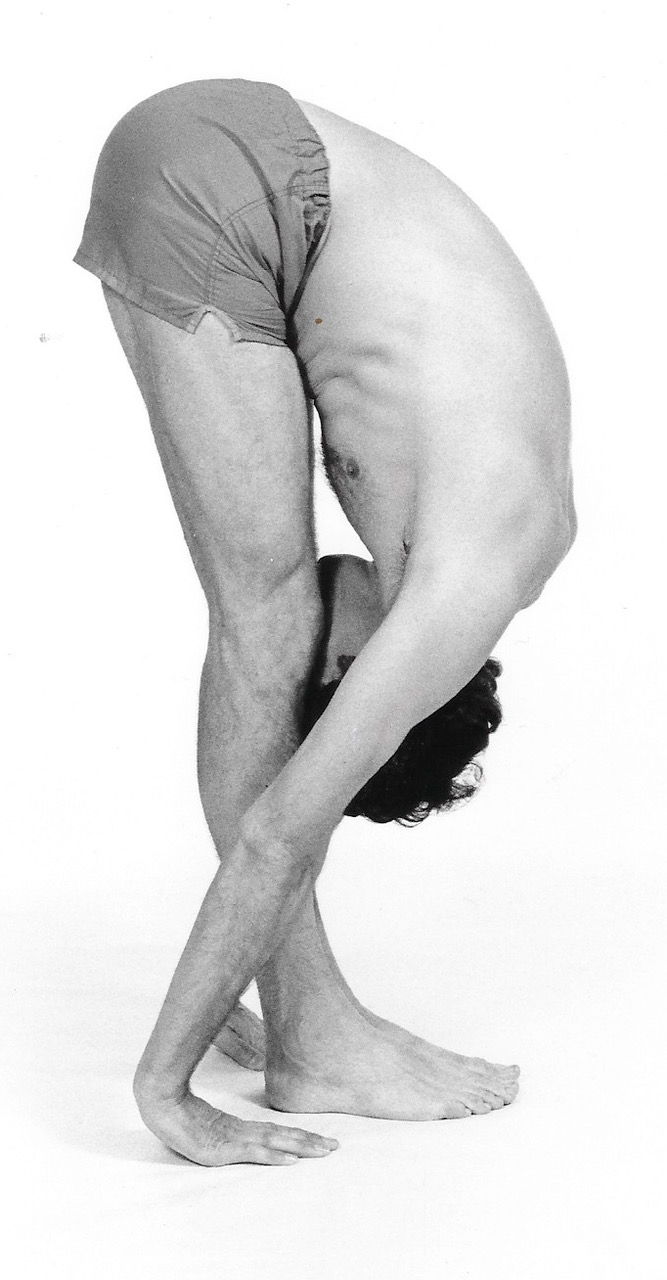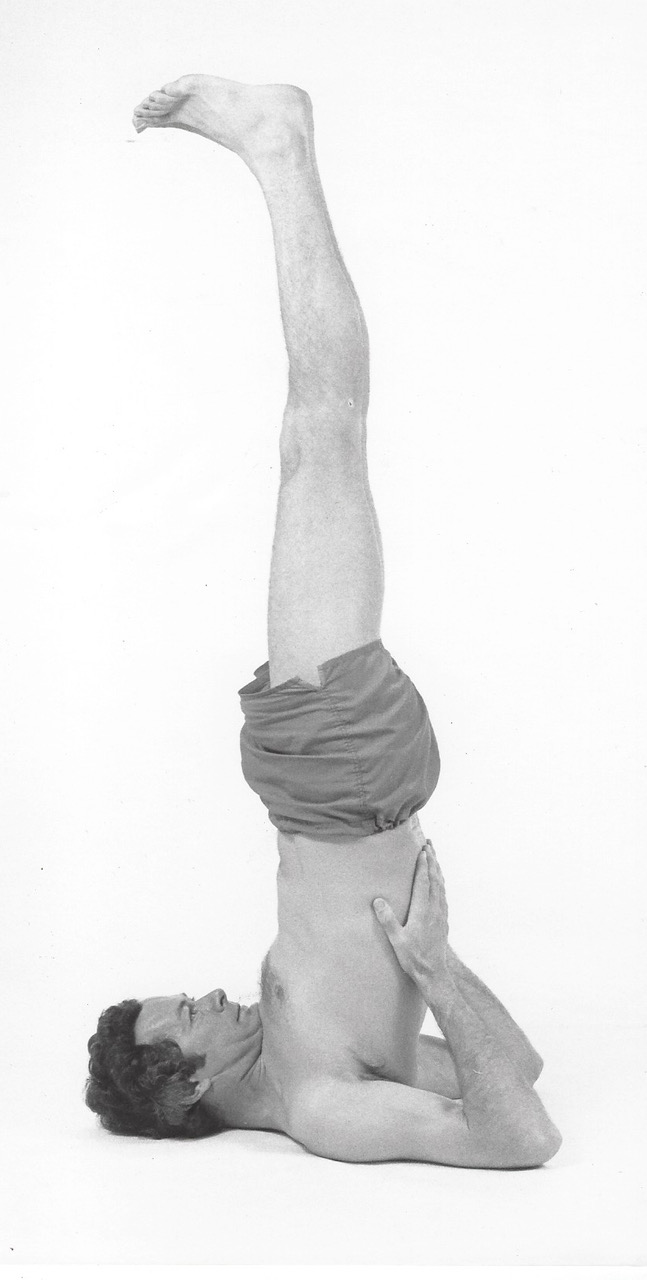Breathing in Yoga Postures

by Ian Rawlinson
Extracts of an article first published in the Yoga Journal
The practice of yoga postures or asanas, to be truly effective, must be adapted to the individual. In this article I will be focusing on the use of the breath in asanas. As you gain an understanding of this principle and also learn to tune into your own mental and physical condition, you will be able to design a practice that meets your own particular needs.
Using the Breath in Asana
Accurate use of the breath adds an important dimension to the practice of asanas. It brings both physical and mental refinement and leads naturally and easily to the practice of yogic breathing or pranayama.
For thousands of years, yogis have realized the profound relationship between one’s mental state and one’s breathing. When we are nervous, frightened, or angry, our breathing is immediately affected, usually becoming short, fast, and shallow. Conversely, when we are relaxed and calm, our breathing is long, slow, and deep. Thus, our breathing often reflects our mental condition.
If we consciously develop slow, calm, deep breathing, one result is a relaxed mind. Although the final aim of yogic breathing is not simply to calm the mind, this is an essential first step.
In Indian philosophy, a pool of water often symbolizes the mind (citta). Activities and desires (vrittis) are characterized as waves that agitate the water’s surface. The different yogic disciplines aim to remove these agitators or waves, and yogic breathing in particular helps still the mind and induce relaxation and harmony.
The basic principles of yogic breathing are very simple:
- Expanding movements are made on the inhalation.
- Contracting movements are made on the exhalation.
- Twisting movements are made on the exhalation.
When you expand your body—e.g., raise your arms above your head—your chest naturally opens. When you inhale the chest and diaphragm also open. Thus, if you inhale with an opening movement of the body, movement and breathing are in harmony.
Conversely, if you bend forward as in Uttanasana (Standing Forward Bend; Figure 1), your chest contracts. And when you exhale, the contraction of chest and diaphragm harmonizes movement and breathing.
The same principle applies to twisting movements. When you are twisting into a posture, the thorax constricts, making it difficult to inhale. To maintain harmony between movement and breathing, it is necessary to exhale when twisting.
Chest Movement
There are two very different ways to fill the lungs. One is to begin by filling the bottom of the lungs first and work up to the top. The other is to fill the top of the lungs first and then work down. Each method has its advantages, and you should consult your teacher to determine which method is most appropriate to your needs.
The main advantage of filling the upper chest first and working down toward the abdomen is that you can produce more movement in the upper chest. Exhalation begins from the bottom of the lungs and works up.
Synchronization of Breathing and Movement
All movements should be carefully synchronized with the breath. You should start breathing just before the movement begins and continue until just after the movement ends. The speed of the breath determines the speed of the movement. The movement should be slow, but not so slow that your breath ends first. Working carefully in this way takes considerable concentration.
Ratios

Once you have mastered the coordination of movement and breathing, you can add further refinements to the use of the breath. You can begin to use particular ratios of breath by counting the length of the breath, mentally or with the help of a metronome. Try to count at one-second intervals.
A further development is to use ratios of breath in the postures. A ratio in breath is a quantitative relation between two or more parts of the breath. A 1:2 ratio indicates that the exhalation is twice as long as the inhalation—e.g., inhale eight seconds, exhale 16 seconds. The breath can also be held or suspended after the inhalation and/or exhalation. So a ratio that includes a short retention after the inhalation and exhalation would be 1:1:1:1, e.g., inhale five seconds, hold five seconds, exhale five seconds, hold five seconds. Retention of the breath adds considerably to the intensity of the practice.
What you find to be a useful ratio may not be useful or suitable for someone else. You must choose a ratio under the guidance of a teacher who can watch your practice and assess exactly how you need to work with the breath.
Advantages of Working with the Breath
There are a number of advantages to working so accurately with the breathing in the asanas.

- It helps develop deep concentration. You cannot possibly synchronize movement and breath and count particular ratios unless your mind is totally absorbed in your practice. The development of concentration is an essential part of all yogic disciplines.
- It adds another dimension to the way you can work in each posture. You can change the effect and feeling of a posture by altering the breathing pattern. For example, using 1:0:2:0 or 1:0:1:1 in Paschimottanasana (Seated Forward Bend; Figure 2) will have a very different effect than using 1:0:1:0.
- It improves the quality of movements. Because you have to concentrate very carefully when using the breath in this way, the whole quality of the movement is improved.
- Breathing helps gauge the effects of practice. If you practice asanas without using the breath properly, you may strain or injure yourself by holding the posture too long. This can be avoided if you observe your breath carefully; if there is any strain, your breathing will immediately become shorter-a clear indication that the posture has been held long enough.
Using the breath can also be useful in extending, in a controlled and measured way, the length of time you spend in a posture. For example, when first learning Sarvangasana (Shoulder Stand; Figure 3), you may find that 12 breaths is the comfortable maximum. Over time, however-perhaps every week or 10 days-you can gradually extend the number of breaths until, without any strain, you can hold the posture five to 10 minutes.
You can also gradually and systematically extend the length of each individual breath. For example, in Uttanasana (Standing Forward Bend; Figure 1) you may have a comfortable breathing ratio of 8:8, which you can gradually extend to 10:10, then 12:12, and so forth.
Asana and Pranayama
Since the two practices are closely related, it is possible to apply the breathing ratios used in the practice of asanas to the practice of pranayama. You will be far better prepared, both psychologically and physically, for the pranayama. For example, if you choose to work a longer exhalation during pranayama, you can prepare for this by using a longer ratio during your asana practice.
By working with the breath in a very precise way, you will find that the effects of practice become far more profound. Hence, it is extremely important that practice be done carefully and accurately, and that you be supervised by an experienced and well-trained teacher.
Other Articles:
The Five Elements
Treating Children with NAET
The Point of the Needle
The Law of Mid-day Mid-night
Treating Depression with Five Element Acupuncture
Maintaining Your Health
Breathing in Yoga Postures
Pulse Taking in Chinese Medicine
The Seasons: Late Summer
The Seasons: Winter
The Seasons: Summer
Treating the Shen
Treating Children with NAET
The Point of the Needle
The Law of Mid-day Mid-night
Treating Depression with Five Element Acupuncture
Maintaining Your Health
Breathing in Yoga Postures
Pulse Taking in Chinese Medicine
The Seasons: Late Summer
The Seasons: Winter
The Seasons: Summer
Treating the Shen
